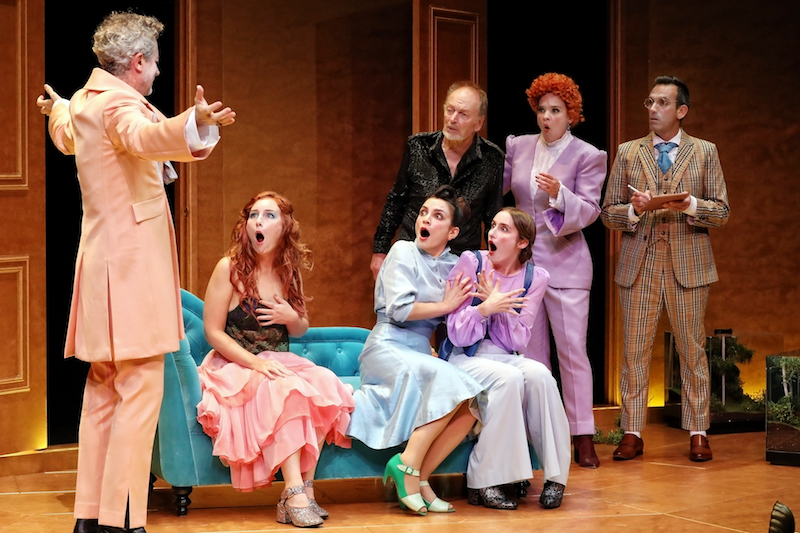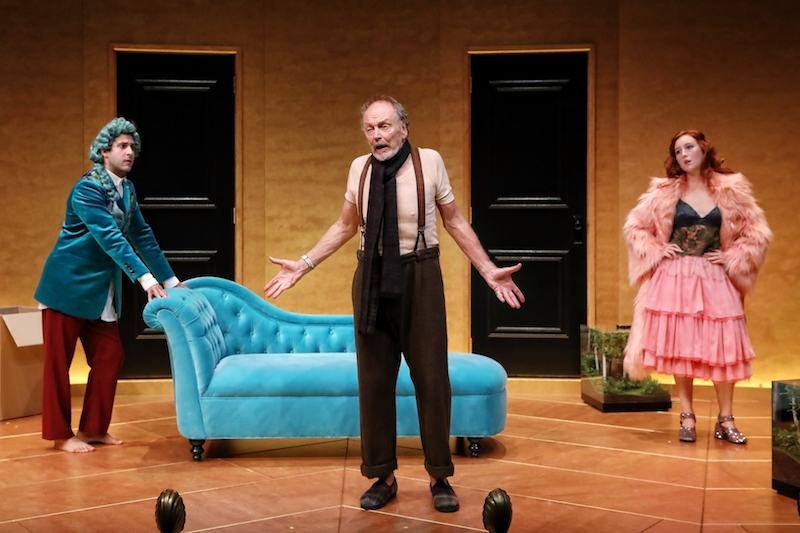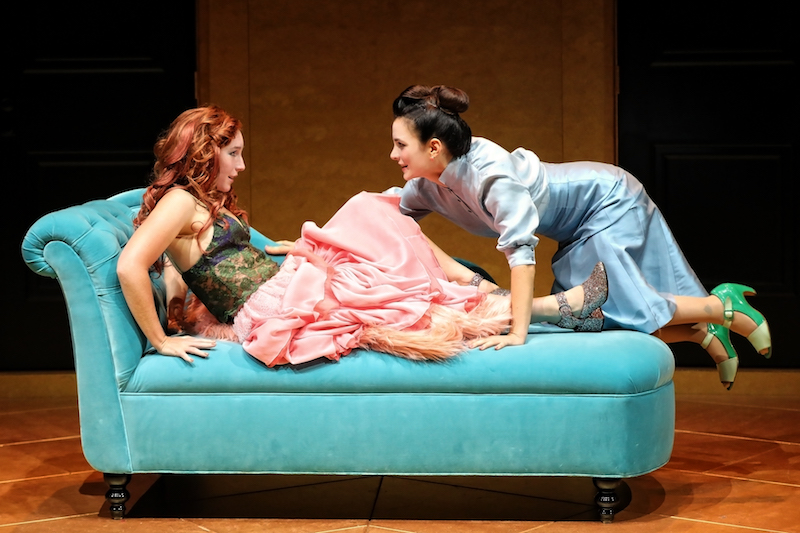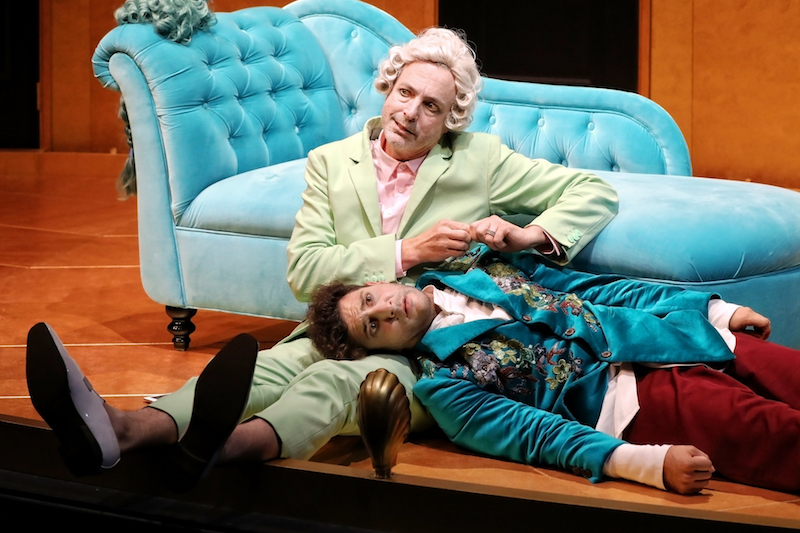With comments like “cut the mustard”, “a pit bull on heat” and an eye-rolling “Oh. My. God.” along with references to “tossers” and “the short and curlies”, you can pretty well guarantee that this new version of Molière’s satirical farce The Miser is unlike any other to have hit the stage.
 Sean O’Shea, Harriet Gordon-Anderson, John Bell, Jessica Tovey, Elizabeth Nabben, Michelle Doake and Russell Smith. Photograph © Prudence Upton
Sean O’Shea, Harriet Gordon-Anderson, John Bell, Jessica Tovey, Elizabeth Nabben, Michelle Doake and Russell Smith. Photograph © Prudence Upton
Justin Fleming has cornered a market adapting Molière’s comedies for Australian audiences, writing them in rollicking, witty, rhyming verse, full of irreverent, colourful, contemporary Aussie idioms and slang. Bell Shakespeare is now presenting its fifth Fleming take on Molière, having previously staged The School for Wives in 2012, Tartuffe in 2014, The Literati (co-presented with Griffin Theatre Company) in 2016, and The Misanthrope in 2018.
Bell Shakespeare’s Artistic Director Peter Evans, who had a huge success with the hilariously funny production of Tartuffe, has donned the directing gloves again for The Miser, with his predecessor John Bell returning to the company to play the title role.
The Miser premiered in 1668 with Molière himself in the role of the brutally stingy skinflint Harpagon. Though most of his plays were written in verse, Molière wrote The Miser in prose – apparently because he had consumption and didn’t have the energy to cope vocally with the demands of verse. Fleming has decided to adapt the play using his ingenious, complicated rhyme schemes, the effect of which certainly add to the comic impact.
The plot centres on the avaricious anti-hero Harpagon (Bell), who is so obsessed with money that he is prepared to sacrifice his children, friendship and dignity in favour of his fortune, which he hoards away. His son Cléante (Damien Strouthos) is in love with a beautiful young woman called Mariane (Elizabeth Nabben), while his daughter Élise (Harriet Gordon-Anderson) loves Valère (Jessica Tovey), who saved her from drowning and who has taken a job as Harpagon’s servant in order to be close to her.
 Damien Strouthos, John Bell and Harriet Gordon-Anderson. Photograph © Prudence Upton
Damien Strouthos, John Bell and Harriet Gordon-Anderson. Photograph © Prudence Upton
Both want to marry their sweethearts, but Harpagon has other ideas. He plans to marry Cléante to an old rich widow, and Élise to the old, rich Signor Anselm (Sean O’Shea), who – glory be – is prepared to take her without a dowry. Meanwhile, Harpagon has his eye on Mariane for himself. Then Cléante’s servant La Fleche (O’Shea) steals the 10,000 gold crowns Harpagon has buried in his garden, and mayhem ensues.
Fleming has stuck pretty faithfully to Molière’s plot line, including the use of asides to the audience. His one big change is to make Valère a woman. It’s neatly done without making any unnecessary fuss about it; no one raises their eyebrows at a same-sex relationship, Harpagon’s only concern is that his daughter marry for money. And it leads to some very funny comments from Valère about how to treat men.
Evans and designer Anna Tregloan have cleverly married past and present in their staging. The simple set is basically an open space with a back wall featuring four doors – a time-honoured farcical tradition – along with a chaise longue and some old-fashioned footlights along the front of the stage. The garden, meanwhile, is portrayed by a few glass tanks with plants in them. The colour comes from the costumes which feel contemporary but which drawn on period lines and include wigs. So while it feels very ‘now’ in a rich-as-all-get-out way, it also links to the period. It’s a world where anachronisms like iPads and coach and (underfed) horses sit happily side by side.
The costumes are a dizzy delight, with everyone flamboyantly dressed in glorious hues, apart from Harpagon himself, who looks like an old frump in daggy brown trousers and slippers – until he slips into something more fetching for Mariane, donning a hilariously inappropriate outfit featuring shiny black trousers, gold jacket, sparkly gold loafers, and a hilariously funny dark wig with centre parting. Ram dressed as lamb to recoin a phrase.
 Harriet Gordon-Anderson and Jessica Tovey. Photograph © Prudence Upton
Harriet Gordon-Anderson and Jessica Tovey. Photograph © Prudence Upton
There is plenty of carry-on with people popping in and out of the doors as you’d expect, and the way the actors lift the chaise longue and make a big deal of moving it around before putting it down, often just inches from where it was previously for new scenes is very funny. There are also some inspired comic moments with a wooden spoon from Jamie Oxenbould who plays both the cook and the coachman. But much of the production feels a bit underpowered and some of the comic effects feel pretty predictable. Overall, it’s enjoyable but you can’t help feeling that it needs an extra boost of energy and pace to lift it to another gear.
Fleming’s writing is extremely clever, the rhyming is ingenious at times, and the use of the Australian vernacular is wonderfully cheeky. Max Lyandvert’s music, much of it on piano, is also highly effective, underscoring the drama beautifully, and resembling a film score in one particularly manic scene. But where I remember laughing out loud, a lot, at Tartuffe and The Literati, here there were far more smiles than actual laughter among the audience. Maybe it’s just that we have now seen a fair few of Fleming’s Molière versions and the use of contemporary colloquialisms no longer has quite the same surprise. Tartuffe is arguably a better play. Tartuffe himself feels more dangerous and so the play feels more dramatic and robust.
Among the strong cast (which also include Russell Smith) Michelle Doake – who plays Frosine, a go-between trying to matchmake Harpagon and Mariane – is the one who really nails the heightened, exuberant comic style, vocally and physically. Every time she appears during the first act (when she has much more to do) the energy of the production lifts. Sean O’Shea is also extremely funny as La Fleche. The way he uses a iPad when explaining a money lender’s exploitative deal to Cléante is comic genius, and he is also joyously ebullient as Signor Anselm.
 Sean O’Shea and Damien Strouthos. Photograph © Prudence Upton
Sean O’Shea and Damien Strouthos. Photograph © Prudence Upton
John Bell is a wonderfully grouchy axis at the heart of the play as the mean-spirited, penny-pinching Harpagon, and his appearance in his youthful finery is a hoot. He also suggests the tragic undertow in the play but there is still room for that to be developed. The final image of him alone on stage with his cherished golden coins, when everyone else has left to party, could have a stronger impact. At the moment, that emotion doesn’t feel quite earnt, but that will doubtless develop as the production settles.
The themes of The Miser are, of course, timeless and timely, and the production is enjoyable. But a pacier energy would lift it to another level, so that those themes really kick in, feel more urgent, and really make their mark.
The Miser runs at the Sydney Opera House until April 6, Canberra Theatre Centre, April 11 – 20, Arts Centre Melbourne, April 25 – May 12











Comments
Log in to join the conversation.